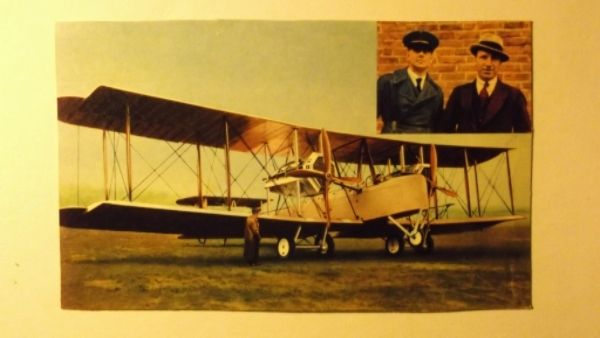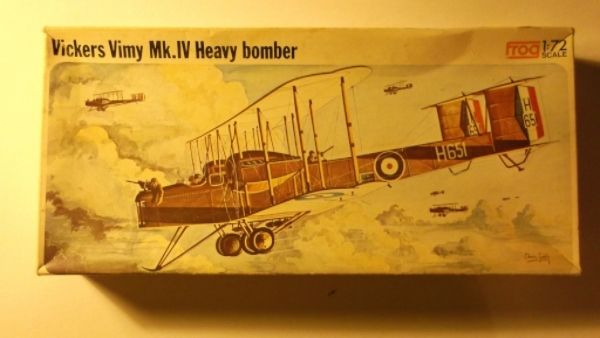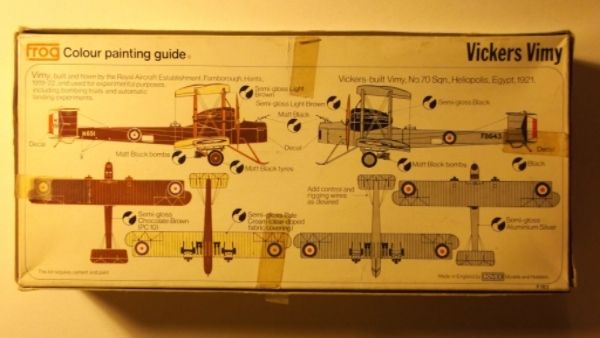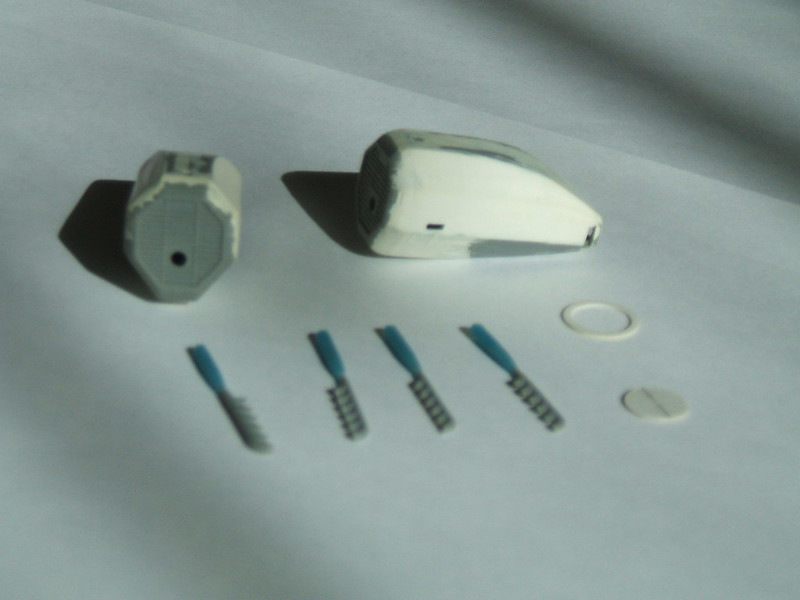Evening All,
In my recent biography I mentioned that I had built a Frog Vickers Vimy over 35 years ago. I thought that as I am between models at the moment and am rather busy I would put up some photos of the model - I cannot provide a build thread as there were no digital cameras with which to take photos at the time, but there is an article in Modelling Madness if anyone wants to follow what I did to turn the model into an RAF machine.
I originally bought the Frog model of the Vimy when it was marketed as one of their Trail Blazer kits: I bought mine in the mid 1960's when it was still relatively new. Some readers may have their memories jogged by this image:

It was the box art of the kit. Sadly it is all I now have - the rest of the box was thrown away nearly half a century ago - and it was a photo of the Vimy used by Alcock and Brown just before they took off on their successful trans-Atlantic crossing in 1919: Alcock and Brown are in the inset. Both photographs used were originally black and white and were hand coloured for the box art. Then in the late 1970's I was able to buy one of the re-released kits where Frog had added some machine guns, bombs and put in gunner's positions in the nose and upper fuselage - they omitted the ventral gun position - and replaced the nose wheel with a skid, which was supposed represent the version used by the RAF.


I happened to find a 1/48 scale drawing of the Vimy and was able to use this together with the Profile number 5 and some other sources to modify and build the kit in a form which more accurately represented H 651 which was used at Farnborough, Hants, UK, between 1919 and 1922 for bombing and automatic landing trials. These images show what I had to do to rectify the kit to make it more accurate.


The remainder of the images are of the model which is now over 35 years old and was rigged with copper wire.

The Vickers F. B. 27 Vimy is probably one of the better-known of the heavy bombers which was in RAF service during the interwar years: this fame is due more to the exploits of this aircraft in civilian guise than to the unglamorous service it gave in the RAF.

The Vimy was originally designed and built as a replacement for the Handley Page 0/400 bombers which saw active service in 1917 and 1918. The first prototype Vimy flew on November 30, 1917, but it took another 11 months before the RAF took delivery of its first machines. On November the 11th 1918 only three had been accepted and none of these was used operationally during the war. The cessation of hostilities in Europe meant that the large wartime contracts for the Vimy were cancelled and the RAF itself was subject to severe cutbacks in its operational strength. Thus the introduction of this new aircraft into service was a somewhat prolonged affair - 58 Squadron in Egypt being the first unit to equip with the type in 1919.

Later in 1921, 45 and 216 Squadrons received Vimys to replace their D. H. 10 Amiens. Meanwhile at home the majority of the aircraft built were placed into store and only one flight of 100 Squadron was equipped with the new bomber in home service. When the RAF was expanded slightly in the early 1920s a flight from 100 Squadron was detached to form the nucleus of a new 7 Squadron. In 1924 two more squadrons, Nos. 9 and 58, were revived and equipped with Vimys from store. These three units for a time provided the entire home-based heavy night bomber force. Vimys remained in the front-line service as bombers until 1929 when 502 Squadron finally relinquished them.


The Vimy was flown with a variety of engines most of which were experimentally fitted to prototype machines. The most commonly used was the well tried Rolls-Royce Eagle VIII, which powered all the bombers in service. However, as time passed and the Eagle engines began to run out of hours and spares, Bristol Jupiter IV or Armstrong Sidley Jaguar IV were fitted to aircraft taken in for major overhauls. These radial engines, (which had previously seen service in Hawker Woodcocks), necessitated a redesign of the engine bearer struts to an “X” configuration. Aircraft fitted with these engines were sent to training units from 1929 as part of an attempt to extend their useful lives, and was a typical economy measure of the time. In the course of their service careers many Vimys were reconditioned and this was reflected in the presentation of the serials on the aircraft in middle east service by the addition of the letter “R” e.g J7444 became JR7444.


The most important and famous event involving a Vimy must undoubtedly have been the first non-stop transatlantic flight by Alcock and Brown on June 14 /15th 1919 from Newfoundland to a bog in southern Ireland. This flight was carried out in a specially modified machine, which is now preserved in the science Museum in South Kensington. A second epic flight was carried out by the Smith brothers, and Bennett and Shiers when they became the first all Australian crew to fly an aircraft from England to Australia in less than 720 hours. Later two unsuccessful attempts were made to fly Vimys from London to Cape Town, both machines being written off during accidents on various stages of the journey.

The white bombs in the above image were those supplied in the kit and are a reasonable representation of the practice bombs used in the early 1920's.

The only transfers that I used from the kit were for the serials - hence the silvering. The remainder were hand painted.

Thanks for looking.
PS (4.11.20): I have replaced most of the original images with new ones. However I do not have the three photographs of the box in my desktop album so these have not been replaced.